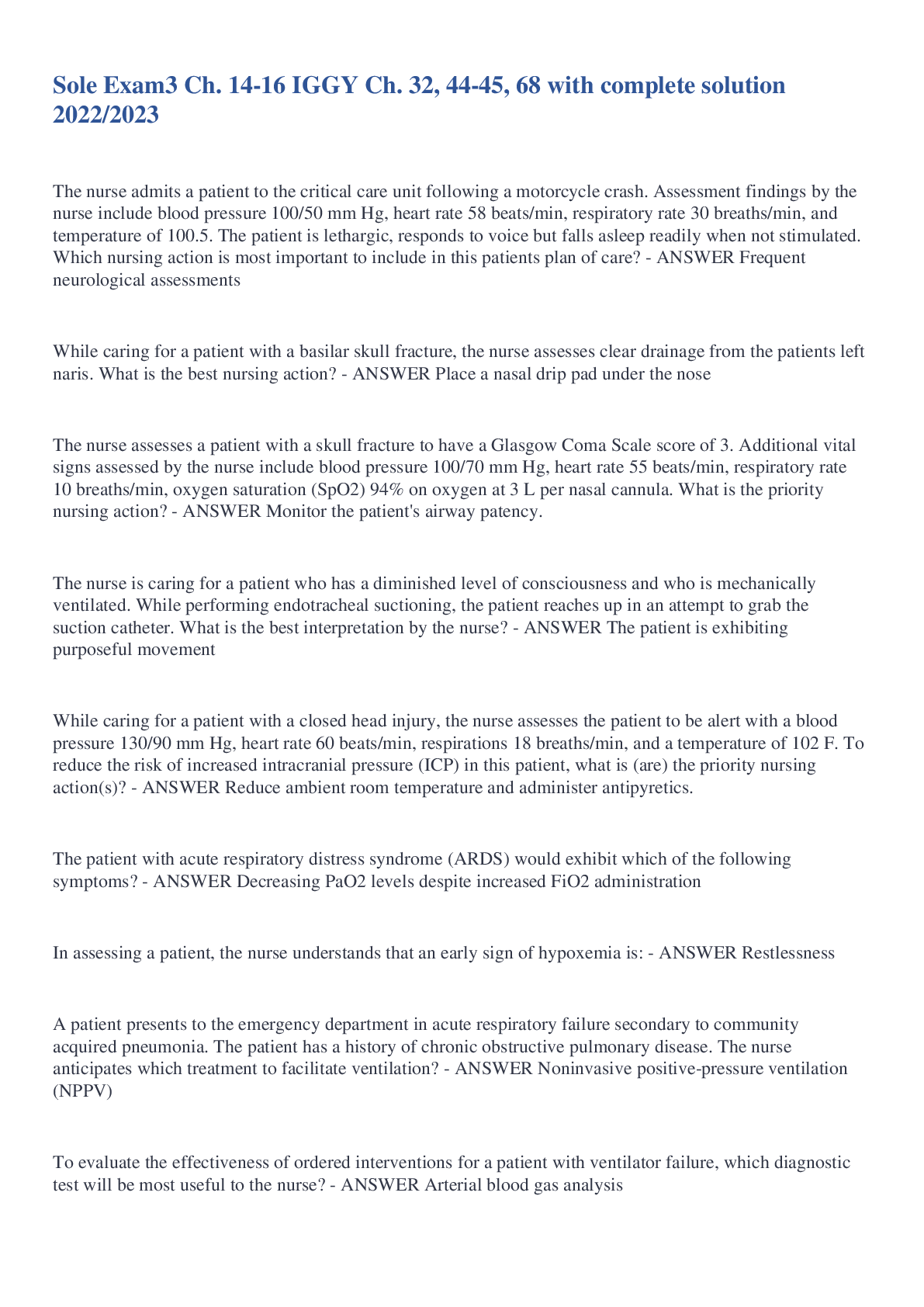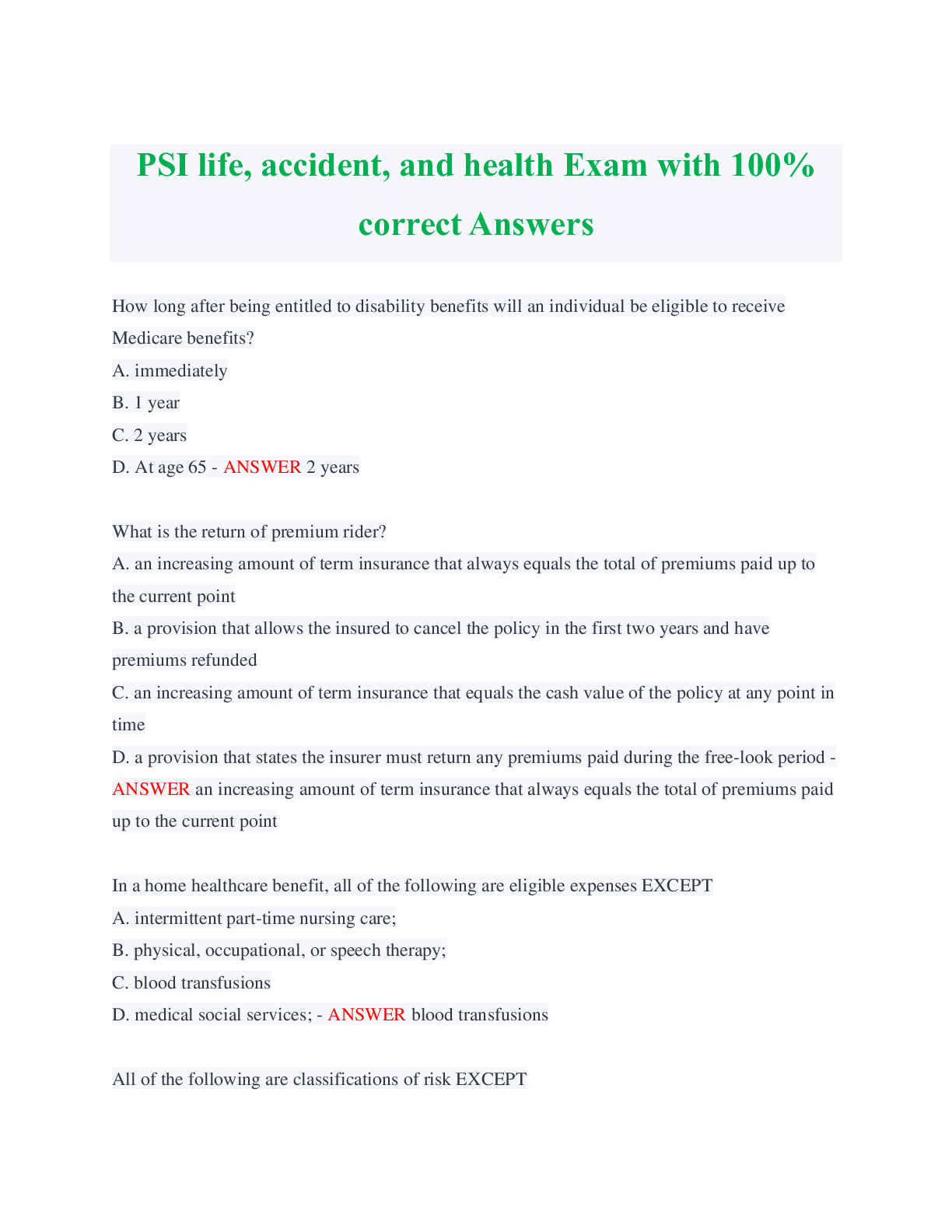Medicine > EXAM > Sole Exam3 Ch. 14-16 IGGY Ch. 32, 44-45, 68 with complete solution 2022/2023 (All)
Sole Exam3 Ch. 14-16 IGGY Ch. 32, 44-45, 68 with complete solution 2022/2023
Document Content and Description Below
The nurse admits a patient to the critical care unit following a motorcycle crash. Assessment findings by the nurse include blood pressure 100/50 mm Hg, heart rate 58 beats/min, respiratory rate 30 br... eaths/min, and temperature of 100.5. The patient is lethargic, responds to voice but falls asleep readily when not stimulated. Which nursing action is most important to include in this patients plan of care? - ANSWER Frequent neurological assessments While caring for a patient with a basilar skull fracture, the nurse assesses clear drainage from the patients left naris. What is the best nursing action? - ANSWER Place a nasal drip pad under the nose The nurse assesses a patient with a skull fracture to have a Glasgow Coma Scale score of 3. Additional vital signs assessed by the nurse include blood pressure 100/70 mm Hg, heart rate 55 beats/min, respiratory rate 10 breaths/min, oxygen saturation (SpO2) 94% on oxygen at 3 L per nasal cannula. What is the priority nursing action? - ANSWER Monitor the patient's airway patency. The nurse is caring for a patient who has a diminished level of consciousness and who is mechanically ventilated. While performing endotracheal suctioning, the patient reaches up in an attempt to grab the suction catheter. What is the best interpretation by the nurse? - ANSWER The patient is exhibiting purposeful movement While caring for a patient with a closed head injury, the nurse assesses the patient to be alert with a blood pressure 130/90 mm Hg, heart rate 60 beats/min, respirations 18 breaths/min, and a temperature of 102 F. To reduce the risk of increased intracranial pressure (ICP) in this patient, what is (are) the priority nursing action(s)? - ANSWER Reduce ambient room temperature and administer antipyretics. The patient with acute respiratory distress syndrome (ARDS) would exhibit which of the following symptoms? - ANSWER Decreasing PaO2 levels despite increased FiO2 administration In assessing a patient, the nurse understands that an early sign of hypoxemia is: - ANSWER Restlessness A patient presents to the emergency department in acute respiratory failure secondary to community acquired pneumonia. The patient has a history of chronic obstructive pulmonary disease. The nurse anticipates which treatment to facilitate ventilation? - ANSWER Noninvasive positive-pressure ventilation (NPPV) To evaluate the effectiveness of ordered interventions for a patient with ventilator failure, which diagnostic test will be most useful to the nurse? - ANSWER Arterial blood gas analysis While caring for a patient who has been admitted with a pulmonary embolism, the nurse notes a change in the patient's oxygen saturation (SpO2) from 94% to 88%. Which action should the nurse take next? - ANSWER Increase the oxygen flow rate. A patient with respiratory failure has a respiratory rate of 6 breaths/minute and an oxygen saturation (SpO2) of 88%. The patient is increasingly lethargic. Which intervention will the nurse anticipate? - ANSWER Endotracheal intubation and positive pressure ventilation The oxygen saturation (SpO2) for a patient with left lower lobe pneumonia is 90%. The patient has rhonchi, a weak cough effort, and complains of fatigue. Which action is a priority for the nurse to take? - ANSWER Assist the patient with staged coughing. A nurse is caring for an obese patient with right lower lobe pneumonia. Which position will be best to improve gas exchange? - ANSWER On the left side A patient with acute respiratory distress syndrome (ARDS) and acute kidney injury has the following medications ordered. Which medication should the nurse discuss with the health care provider before giving? - ANSWER Gentamicin (Garamycin) 60 mg IV A patient develops increasing dyspnea and hypoxemia 2 days after heart surgery. To determine whether the patient has acute respiratory distress syndrome (ARDS) or pulmonary edema caused by heart failure, the nurse will plan to assist with - ANSWER Insertion of a pulmonary artery catheter. Which statement by the nurse when explaining the purpose of positive end expiratory pressure (PEEP) to the family members of a patient with ARDS is accurate? - ANSWER "PEEP prevents the lung air sacs from collapsing during exhalation." A patient with acute respiratory distress syndrome (ARDS) is placed in the prone position. When prone positioning is used, which information obtained by the nurse indicates that the positioning is effective? - ANSWER The patient's PaO2 is 89 mm Hg, and the SaO2 is 91%. A nurse is caring for a patient who is orally intubated and receiving mechanical ventilation. To decrease the risk for ventilator-associated pneumonia, which action will the nurse include in the plan of care? - ANSWER Elevate head of bed to 30 to 45 degrees. A patient admitted with acute respiratory failure has a nursing diagnosis of ineffective airway clearance related to thick, secretions. Which action is a priority for the nurse to include in the plan of care? - ANSWER Offer the patient fluids at frequent intervals. After receiving change-of-shift report on a medical unit, which patient should the nurse assess first? - ANSWER A patient with septicemia who has intercostal and suprasternal retractions A patient with chronic obstructive pulmonary disease (COPD) arrives in the emergency department complaining of shortness of breath and dyspnea on minimal exertion. Which assessment finding by the nurse is most important to report to the health care provider? - ANSWER The patient's pulse oximetry indicates an O2 saturation of 91%. When assessing a patient with chronic obstructive pulmonary disease (COPD), the nurse finds a new onset of agitation and confusion. Which action should the nurse take first? - ANSWER Assess oxygenation using pulse oximetry. The nurse is caring for a 33-year-old patient who arrived in the emergency department with acute respiratory distress. Which assessment finding by the nurse requires the most rapid action? - ANSWER The patient's PaO2 is 45 mm Hg. The nurse is caring for a 78-year-old patient who was hospitalized 2 days earlier with community-acquired pneumonia. Which assessment information is most important to communicate to the health care provider? - ANSWER Decreased oxygen saturation to 90% with 100% O2 by non-rebreather mask. Which nursing interventions included in the care of a mechanically ventilated patient with acute respiratory failure can the registered nurse (RN) delegate to an experienced licensed practical/vocational nurse (LPN/LVN) working in the intensive care unit? - ANSWER Insert an indwelling urinary catheter. The nurse is caring for a patient who is intubated and receiving positive pressure ventilation to treat acute respiratory distress syndrome (ARDS). Which finding is most important to report to the health care provider? - ANSWER Red-brown drainage from orogastric tube During change-of-shift report on a medical unit, the nurse learns that a patient with aspiration pneumonia who was admitted with respiratory distress has become increasingly agitated. Which action should the nurse take first? - ANSWER Use pulse oximetry to check the oxygen saturation. Which actions should the nurse initiate to reduce the risk for ventilator-associated pneumonia (VAP) (select all that apply)? - ANSWER Provide a "sedation holiday" daily. Elevate the head of the bed to at least 30°. Give prescribed pantoprazole (Protonix). Provide oral care with chlorhexidine (0.12%) solution daily. (oral care q2) [Show More]
Last updated: 2 years ago
Preview 1 out of 6 pages

Buy this document to get the full access instantly
Instant Download Access after purchase
Buy NowInstant download
We Accept:

Reviews( 0 )
$10.00
Can't find what you want? Try our AI powered Search
Document information
Connected school, study & course
About the document
Uploaded On
Sep 30, 2022
Number of pages
6
Written in
Additional information
This document has been written for:
Uploaded
Sep 30, 2022
Downloads
0
Views
48














.png)

